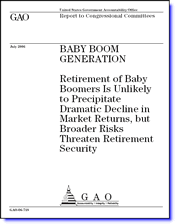GAO Study Pooh-Poohs The Baby Boomer Bust
by John Schroy filed under Equities, Individual Investors
In July 2006, the GAO issued a seventy page report on the Baby Boom Generation, with the headline conclusion, “Retirement of Baby Boomers Is Unlikely To Precipitate Dramatic Declines in Market Returns, But Broader Risks Threaten Market Security“.
 The GAO Enters The Fray
|
||
A careful reading of this report shows that the conclusions were based on the following studies and observations by the Government Accountability Office:
Many people on Wall Street who were interviewed said that there was nothing to worry about.
Two-thirds of Baby Boomer assets are held by 10% of the population who the study concluded are so rich that they won’t need to sell stocks when they retire.
One-third of Baby Boomers don’t have any stocks at all, so they won’t be able to influence the market by selling.
Many economists performed regression analyses on past market data, while others developed simulation models of how they expected the market to operate over the next generation, and none of these experts could seem to find any provable relationship between the impending retirement of the Baby Boomers and stock market returns — with half of their results correlating to ‘unknown factors’.
The Baby Boomers will retire gradually over a generation, so the impact of their retirement on the market will never be sudden.
If the Baby Boomers think they are running out of money, they will just postpone retirement, get a job, or spend less, rather than sell stocks.
Thus the government has entered to fray about the Baby Boom Bomb, already noted in a previous article covering the debate between Professor Jeremy Siegel and Michael Milkin.
The GAO’s conclusion seems to be: Don’t Worry, Be Happy (Maybe).
Flaws in the Government’s Argument
Perhaps the greatest error in the GAO study is the underlying assumption that without a massive sell-off by Baby Boomers, there can be no ‘melt-down’ in equity prices.



